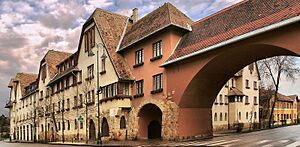Károly Kós facts for kids
Quick facts for kids
Károly Kós
|
|
|---|---|
 |
|
| Born |
Károly Kosch
16 December 1883 Temesvár, Austria-Hungary (today Timișoara, Romania)
|
| Died | 25 August 1977 |
| Nationality | Hungarian |
| Citizenship |
|
| Alma mater | Technical University of Budapest |
| Occupation | Architect |
| Spouse(s) | Ida Balázs |
| Children | 4 |
Károly Kós was a talented Hungarian architect, writer, and politician. He was born as Károly Kosch on December 16, 1883, and passed away on August 25, 1977. He lived and worked in both Austria-Hungary and Romania during his lifetime. Kós was also an illustrator and studied different cultures (an ethnologist).
Contents
Károly Kós's Early Life and Education
Károly Kós was born in a city called Temesvár, which was part of Austria-Hungary. Today, this city is known as Timișoara in Romania.
He first studied engineering at the Royal University of Technology József in Budapest. Later, he decided to switch to architecture and graduated from the Budapest Architecture School in 1907.
Even when he was a student, Kós was very interested in old and traditional folk buildings. He traveled to places like Kalotaszeg and the Székely Land to study them.
Important Buildings Designed by Kós
Károly Kós designed many important buildings. His early work was influenced by styles like Vienna Secession and Art Nouveau. These were popular art and architecture styles at the time.
Some of his well-known projects include:
- The Roman Catholic church in Zebegény (1909).
- The Reformed church building in Óbuda (1909).
- The Budapest Zoo complex (1910), which he designed with Dezső Zrumeczky.
Later, he completed the Reformed Rooster Church in Kolozsvár. This city is now known as Cluj or Cluj-Napoca. He also designed a hospital in Sepsiszentgyörgy, which is now called Sfântu Gheorghe.
Kós During World War I
In 1914, when World War I began, Kós moved to a place called Sztána, now known as Stana. He was called to join the army the next year. However, he was soon released because the Ministry of Culture asked for it.
Between 1917 and 1918, he went on a study trip to Istanbul. In 1918, Kós was offered a job as a professor in Budapest. But he said no because he wanted to go back to Transylvania.
Kós's Political Career
After the war, Kós started a career in politics. Unlike many other Hungarians in the region, he accepted that the Romanian Kingdom now governed Transylvania. He chose to work within the legal system to support his community.
He even wrote a message encouraging others to do the same. In 1921, Kós helped start the Transylvanian People's Party. This group later became part of the Magyar Party. Kós also edited a political magazine called Vasárnap.
Publishing and Cultural Work
In 1924, Károly Kós and his friends created a publishing house. They named it Erdélyi Szépmíves Céh, which means "Transylvanian Guild of Fine Arts."
From 1931, he was the editor of a magazine called Erdélyi Helikon. He also managed the Miklós Barabás Guild. This was a group for Hungarian artists in Romania who wanted to work independently.
Later Life and Contributions
In 1944, during World War II, Kós's house in Sztána was robbed. He then moved to Kolozsvár to be with his family. He became the director of the Transylvanian Hungarian Economic Association.
As a politician, he led the Hungarian People's Union (MNSz). He was also a member of the Assembly of Deputies from 1946 to 1948.
Kós taught at the College for Agriculture in Cluj until 1953. He was even the dean of the college in 1945. He also wrote for a journal called Világosság between 1948 and 1949. Károly Kós passed away in Cluj.
Buildings designed
- 1908-1910
- Reformed Parish Church, Óbuda
- Roman Catholic Church, Zebegény; with Béla Jánszky
- Zoo buildings, Budapest; with Dezső Zrumeczky
- the Varjuvar, Kós' house in Sztana
- 1910-1913
- Városmajor Street, Budapest; with Dénes Györgyi
- Wekerle estate, Budapest
- Székely National Museum, Sfântu Gheorghe (Sepsiszentgyörgy)
- Church with the Rooster, Cluj
- 1930s and 1940s
- Kós' house in Miskolc
- Exhibition Hall, Cluj
- King Matthias House restoration, Cluj
- Milk hall, Mera village, Baciu
Novels
- Varjú nemzetség ("The Varjú Kin", 1925)
- A Gálok ("The Gál Family", 1930)
- Országépítő ("The Country Founder", 1934)
See also
- Transylvanianism


